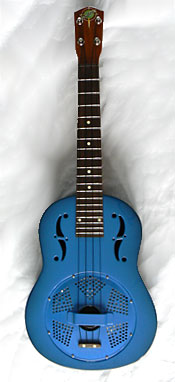There are two models of Tenor uke shown:
#1 is the long standing traditionally shaped model with f holes
#2 is a cutaway design based on the blue uke #2 shape.
Inspite of the differences in looks they both sound the same.
The tenor uke is normally tuned to the same pitch as the concert uke GCEA but has a longer 17”scale length which makes the fret spacings further apart. Fingering is easier on these models for people with large fingers.
Shown here are a few of the variations already tried with these models but any other suggestions are gratefully accepted.
1. Low G or High G stringing on the 4th string.
The low wound G gives a more guitar sound and widens picking options along the lines of a tenor guitar. The high G is the same as the conventional arrangement for concert and soprano ukes.
2. Steel Stringing.
This is great for slide playing or just a more bluesy edge.
3. The Baritone Variation
Replaces the 17” scale length tenor neck with a short baritone one of 19”. This deepens the sound but still allows the instrument to be tuned up to the same pitch as the tenor.
4. The 6 String “Lili’U” variation
Named after the Hawaiian Queen Lili’ukolani. This is a tenor uke with two added strings. The first and third course are doubled. The first having a lower octave wound string and the third a higher octave string. It may sound like an odd arrangement but the sound is unique and accompanies the voice beautifully.
5. The Square-neck Lap Uke.
Another instrument unique to Beltona – the concept suggested and played by ukemaster James Hill. It features a raised nut, square wooden neck and a 24 fret fingerboard with inlayed fret markers in place of metal frets. It is held flat on the lap and its metal strings are played with an overhand metal slide in the Hawaiian steel guitar style.


